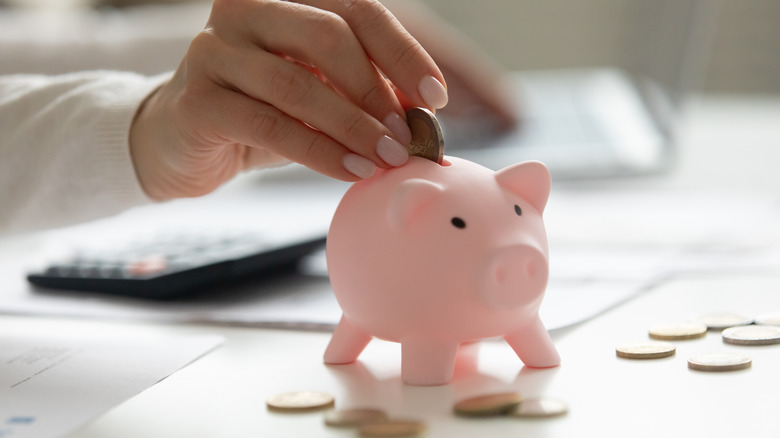Lifestyle Creep: Our Guide To Preventing Personal Inflation
Most people believe a raise or lottery win would solve all their financial woes. They could, in theory, afford a better house, a new car, or fancier clothes, if only they had more money. But money and all the things it buys can become a trap that is becoming known as "lifestyle creep." According to Investopedia, lifestyle creep — also known as lifestyle inflation — is "the phenomenon where discretionary consumption increases on non-essential items as the standard of living improves." Often, when people get a raise, inheritance, or another boost in income, their spending increases with it.
It makes sense that you may want to treat yourself more once you start getting larger paychecks, but lifestyle creep can have negative consequences. "Where it becomes problematic is when the increase in lifestyle outpaces the increase in income," Clint Camua, a financial advisor, told Insider. "It then invades your ability to save for retirement, uses your emergency fund, or increases debt."
If your expenses are creeping up, it's time to get your budget back on track. Here's how to slow down lifestyle inflation and take control of your finances.
Identify the signs of lifestyle creep
Chances are you aren't eating instant ramen for dinner or only hitting up thrift stores for clothes anymore. It's normal to loosen your budget a bit after you've built your career and reached a certain level of financial stability. However, lifestyle creep may be hiding in the shadows. "As you hit each life stage, things get more expensive," Thomas Kopelman, co-founder, and financial planner at AllStreet Wealth, explained to HubSpot. "You go from renting to buying a house, to having kids, and all of those lifestyle changes bring small expense changes. It's gradual and hard to see."
So what are some tell-tale signs of lifestyle creep? One red flag is that you're not sure where your money went at the end of each month. Another sign, according to Synchrony Bank, is that your daily habits have shifted. Now, you go out with friends more, order overpriced take-out instead of cooking, go on frequent vacations, and ditched your neighborhood runs for a fancy gym membership.
If you're still not sure if lifestyle inflation is creeping into your finances, consider tracking your spending. Keep a log of everything — yes, everything — you spend money on for at least a month to see where your dollars are leaking.
Understand your money mindset
To take control of your spending, you need to look at yourself just as much as — if not more than — you look at your bank account. Your beliefs and attitudes about money can influence how you manage your finances, says The Motley Fool. Getting to know your money mindset and the motives behind your expensive lifestyle will make it easier to make smart spending choices in the future.
Consider what justifications bubble up when you're ordering a pricey latte or designer goods that'll barely fit in your overflowing wardrobe. Are you spending money to cheer yourself up on a bad day? Do you want to fit in or keep up with the influencers you admire on Insta? Or did you grow up in a low-income household and want to prove that you've "made it"?
Question the beliefs and reasoning behind your money habits, and trace them back to your self-image. As an artist and financial planner, Paco de Leon summed up to NPR, "Our relationship with money is a mirror. [...] How we choose to spend or not spend our money is a reflection of how we feel about ourselves."
Set up a budget
Earning more money may mean you no longer have to live paycheck to paycheck or hawkishly watch your cash flow. Still, it's a good idea to make a budget, especially if you're noticing signs of lifestyle inflation. The point of a budget, says Consumer.gov, is to organize necessary expenses and pinpoint areas where spending can be reduced. Then, you can decide how to use the money you've saved more wisely.
There are numerous budget templates and methods to choose from, such as the 50/30/20 rule. No matter which one you pick, your budget should leave some room for discretionary spending — after all, nixing lifestyle creep doesn't mean you're not allowed to have any fun with money. However, purchases like trendy clothing or festival tickets shouldn't get in the way of your financial goals. For example, you may need to initially allocate more for your emergency fund, which experts say should equate to between three and 12 months of expenses, depending on your income and personal circumstances (per The Balance). You should also tackle any outstanding debts, such as student loans or credit card balances, before shelling out more for lifestyle luxuries.
Prioritize how you'll use extra money
Whether you believe that money buys happiness or not, it's clear that money can at least buy things that contribute to our happiness — think a beachy summer trip or a comfy home in a neighborhood you love. "None of [these luxuries] are forbidden or gluttonous on their own," Katie Waters, a financial planner, explained to Real Simple. "The [lifestyle] creep lies in mandating that you have all of them: the house, the cars, the travel budget, the kitchen/backyard/basement/bathroom remodel, the private schools."
To keep yourself from getting carried away, determine the top one or two things you want to spend more money on. Maybe you've been driving a car for years that routinely breaks down and now you can finally afford to replace it. Invest in a car if that's your priority, and then ease up on the take-out food, new wardrobe pieces, and kitchen renovation plans until you've paid off your new ride.
Get a grip on impulse buying
When you start to have more money in the bank, it's easy to make spontaneous purchases, knowing you don't have to fret about being in the red. But when impulse buying becomes the norm, lifestyle creep is much more likely to swoop in and wreck your budget.
A 2022 survey by SlickDeals proves this. It found that the average shopper spends $314 each month on spontaneous purchases — a sizable chunk that might be better directed to your retirement fund or savings account. So does that mean you should stop all non-essential purchases? Not exactly, but you might want to pause before buying those $100 boots you didn't even know existed until 20 seconds ago.
"Anytime there is an item you want that is over $50, wait a week to buy it. Then it is no longer a true impulse buy if you still want it," Sophia Bera, founder of Gen Y Planning, suggested to CNBC. Consider creating a wishlist of your desired items or letting them sit in your cart without hitting the "buy" button. By the end of your waiting period, you might realize your interest in the item has faded and you'd rather spend your money elsewhere.
Treat yourself in new ways
According to Investopedia, lifestyle creep often happens when people believe they've earned the right to spend more money on unnecessary goods. This is a common feeling to have after working your way up the career ladder or putting in overtime hours to build your side hustle. Unfortunately, treating yourself becomes less of a treat when you've maxed out your credit card or can't afford an emergency expense.
Still, treating yourself feels good, says psychologist Dr. Justin Puder. "When we are in the process of treat-culture shopping, dopamine is released, " he told Well+Good. "This happens because as we look at different items or compare things we may buy, our brain is anticipating a reward, increasing our motivation to shop and creating this shopper's high."
Going cold turkey on treat-yourself shopping can be easier said than done. Instead, try replacing retail therapy with another (inexpensive) form of self-care. Nourish your body with a favorite home-cooked meal, or pamper yourself with a DIY spa night after work. Free activities like exercising, meeting up with a friend, or volunteering can also be major mood boosters. Find a treat that works for you, without breaking the bank.






